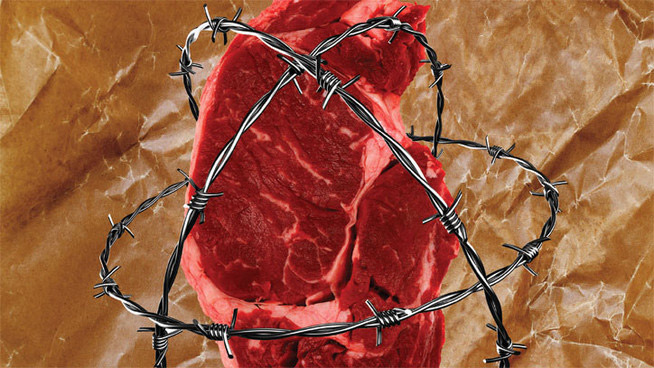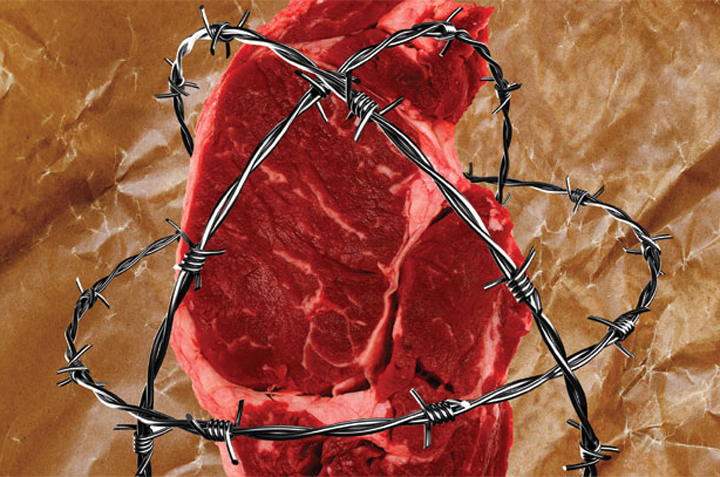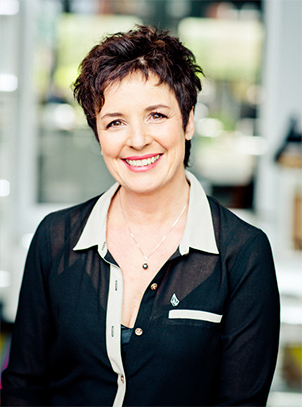Meat at the heart of the meal
Meat is often a dinner staple. Frances Moore Lappé published a revolutionary book in 1971 called Diet for a Small Planet. This American author noted that meat had become the centre of our meals and vegetables were reduced to a supporting role. When kids ask Mom what's for dinner… the answer is pork roast, steak, chicken, meatloaf.
A lot of people find it hard to imagine a meal without meat, whether it's our cousins south of the border or here in Canada. Eating steak every night of the week is part of the American Dream. Ms. Moore Lappé noted a dramatic increase in beef consumption in the United States starting in the 1950s. She shed light on the issues of waste and the excessive amount of protein consumed in relation to our needs. She advocated a better use of resources. After a period of long reflection, she raised the question: Can we eat more vegetables and less meat and still be healthy? She suggested taking baby steps to get there by starting with one meatless meal a week. This was the beginning of the food revolution in America.
A meal without meat?
This idea wasn't born yesterday. Until the middle of the 1960s, the Catholic Church forbade its followers to eat meat on Friday, the day of Jesus' death. Meat and sexual relations were forbidden on lean days due to ambiguity over the meaning of "flesh." Coming from cold water, fish was thought to be lean and therefore allowed (even though it was not always fresh and often overcooked).
To support the war effort during World War I, the US Food and Drug Administration recommended that families reduce their consumption of some staple foods, including meat and wheat, and so Meatless Monday and Wheatless Wednesday were born.
More recently, the Meatless Monday initiative resurfaced in 2003 after joining forces with the reputable School of Public Health at Johns Hopkins University. The goal? Raise awareness about the importance of reducing our consumption of saturated fat to prevent many health problems. A new issue has been added to the mix, because meat or pork production takes a lot of energy, antibiotics and water: up to 70,000 litres of water per kilogram of meat produced. There's a ratio of six kilograms of feed required to fatten up cattle per kilogram. So there are now environmental and ethical considerations added to this vast campaign.
Support pours in from everywhere!
Many organizations and individuals around the world have added their support to Meatless Mondays. Former U.S. Vice-President Al Gore, a long-time activist and Nobel Prize winner concerned about the environment and dangers of global warming, has said that, though he isn't a vegetarian, he has significantly reduced his meat consumption. Even chef (and diehard carnivore) Mario Batali has jumped on the bandwagon. Every Monday, his 14 restaurants based in New York, Los Angeles and Las Vegas offer two main dishes without meat, bearing the MM logo (Meatless Monday).
Ex-Beatle Sir Paul McCartney, a vegetarian for more than 30 years, as well as Sheryl Crow and Coldplay promoted the Meat Free Monday movement in England in 2009 aimed at slowing down climate change. Meals without meat are now served at the popular Hard Rock Café in London as well as at Oxford University. In fact, Yoko Ono sends a message to her 700,000 Twitter followers every Monday, saying: "Give up meat one day and then two days maybe. It's a very, very intelligent idea."
The city of Cape Town in South Africa was the first city in Africa to officially endorse the movement through its Health Portfolio Committee. The city of San Francisco, California encourages its schools, restaurants and grocery stores to offer vegetable-based meals. Meatless Monday is par for the course at Puma's head office in Germany, at Tel Aviv University, in Israel, and at dozens of other institutions.
The Meatless Monday movement exists across Canada. Many organizations, such as the David Suzuki Foundation, as well as stars like Titanic director James Cameron and Oprah, have voiced their support. During talks with nutritionist colleagues that are influential in public health policy, some question the marketing angle of the movement. Why promote a negative approach (meat free) based on depriving yourself of a food or food group (meat, poultry, seafood, but also cheese and dairy products for many activists since they come from livestock) when the point is to encourage people to eat more legumes, whole grains, fruit and vegetables? Why not a more positive approach about the variety of delicious, amazing foods out there that should be found more often on our plates. An interesting debate!
The Meatless Monday campaign is not trying to force you to refrain from eating meat on Mondays, it's offering an invitation to become aware of the impact our food choices have on the planet and our health. Adopting better habits is a good place to start.
In the Ricardo magazine (in French only), every issue contains several seasonal meatless recipes. There is a Lundi sans viande (Meatless Monday) recipe specially created to help you if you are lacking some inspiration.
Too much red meat: health risks
The term red meat refers to beef, lamb, liver, pork (sometimes classified as white meat), sausages, and cold cuts made from these meats. Like it or not, there are significant health risks associated with eating a lot of red meat: 30% higher risk of death among big meat eaters, 20% higher risk among lovers of smoked sausage, bacon and other transformed meats. This startling data was published last year by researchers at the National Cancer Institute. It is based on a large study conducted over ten years among 500,000 Americans aged 50 to 71. Solid links were found between the consumption of red meat and cardiovascular illnesses, as well as several cancers, including colorectal cancer.
The myth of incomplete proteins
An out-of-date theory still making the rounds says you have to combine certain vegetables with each meal (ex. Legumes + cereal product) to obtain complete proteins. Even though it is obsolete, it persists, even among some health professionals … There a really simple rule to follow to allow us to meet our protein requirements: eat various vegetable food products during the day and not at each meal: soy and legumes, nuts, grains, cereal products, fruit, vegetables. There's really no need to worry if you want to add eggs or milk products to your menu.
Replacing animal protein: what is there to eat?
The possibilities are as endless as your imagination. Get your protein from beans and peas, lentils, eggs, soy products, nuts and seeds. On the cereal side, opt for rice, oats, quinoa, corn, barley, whole wheat pasta, bread and couscous. Add vegetables and fruit for colour and flavour. It's easy!
10 vegetarian suggestions
- Instead of beef and barley soup: try pea soup without bacon
- Instead of Bolognese sauce on your pasta: try pasta with tomato sauce cannellini (small white beans)
- Instead of traditional shepherd's pie: try shepherd's pie with meatless meat you can find at the grocery store
- Instead of bacon on your salad: try pine nuts or sunflower seeds
- Instead of a chicken fajita: try a red bean burrito
- Instead of a turkey sandwich: try a sandwich with pesto, tomato and bocconcini
- Instead of rillette or creton: try hummus or vegepâté
- Instead of steak: try vegetarian chili
- Instead of couscous with merguez sausage: try couscous with vegetables and chickpeas
- Instead of chicken fried rice: try a tofu and vegetable sauté with rice
Do we have to completely abandon meatballs and pepperoni pizza? Do health experts eat meat in secret or are they all vegetarians? The answer is no, of course, but it's a good idea to follow these tips:
- Decrease your meat consumption to 1 to 3 times a week.
- Pay attention to portion control, suggested serving is 85 g (3 oz), the size of a computer mouse.
- Accompany meat with generous portions of vegetables.
- Buy nitrate-free cold cuts more often.
- Eat more legumes, eggs, tofu, poultry and fish.


